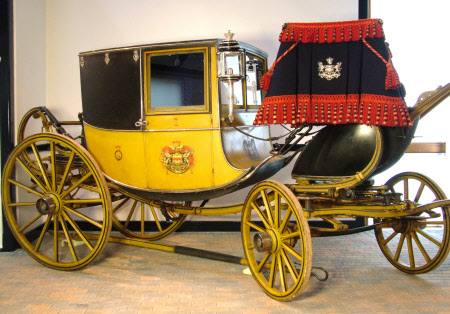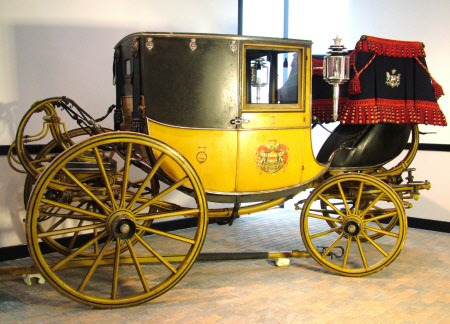State chariot
Hooper and Co.
Category
Carriages & other vehicles
Date
1850
Materials
Painted wood body with silk upholstery and four iron shod wheels.
Measurements
217 x 404 x 189cm (7ft 1 1/2in x 13ft 3in x 6ft 2 1/2in)
Place of origin
London
Order this imageCollection
National Trust Carriage Museum
NT 272915.1
Caption
State carriages were only owned by the nobility and used on very important occasions such as the State Opening of Parliament, society weddings and grand receptions. This is one of the most important and magnificent carriages in the collection, it has silver-plated furniture and coats of arms. The interior is beautifully lined in bright peacock blue damask.
Summary
State Chariot built for the Earl of Craven by Hooper and Co. of London circa 1850. State Chariot (four wheels) for a team of horses. This chariot has its hammer cloth in original condition with lamps and pole. It is sprung on on C and under springs. The interior is of blue silk damask trim, with three loose cushions. Painted in yellow and black livery with black lining. With Craven family crest on 3 sides, front and rear. On loan from Lord Craven's Estate.
Full description
This chariot is one of the most important carriages in the Arlington Court collection. Not only is it in original un-restored condition, but also it is an example of the work of Hooper & Co., one of the very finest London coachbuilders of the 19th century. It has silver-plated furniture including axle caps and stock hoops, head plates (the crests of the Craven family on the upper quarter panels), snake head body loops and beautiful decorative terminations to the plated pin beads. It also has the silver-plated coats of arms of the family on the hammer cloth. The interior is beautifully lined in a bright, very rich shade of blue damask. It is called a chariot because of the shape of the body. A coach seats four inside the body, and therefore has a seat ahead of the doors and one behind them. A chariot only seats two on a seat behind the doors. This chariot was built for the Earl of Craven between 1831 and 1836. State carriages were only owned by the nobility and used on very important occasions such as the State Opening of Parliament, society weddings and grand receptions. This very limited use has kept it, and other vehicles like it, in excellent condition.
Marks and inscriptions
On nearside side panel.: Craven family crest. On offside side panel.: Craven family crest. On rear panel.: Craven family crest. On front nearside axle cap.: HOOPER & CO LTD LONDON On front offside axle cap.: HOOPER & CO LTD LONDON On rear nearside axle cap.: HOOPER & CO LTD LONDON On rear offside axle cap.: HOOPER & CO LTD LONDON On bosses on panel blinds.: HOOPER & CO VICTORIA ST LONDON SW On front nearside axle components : CHARLES COLLINGE No 22 BRIDGE ROAD LAMBETH On front offside axle components.: CHARLES COLLINGE No 22 BRIDGE ROAD LAMBETH On rear nearside axle components.: CHARLES COLLINGE No 22 BRIDGE ROAD LAMBETH On rear offside axle components.: CHARLES COLLINGE No 22 BRIDGE ROAD LAMBETH On front nearside axle components.: C On front offside axle components.: C On rear nearside axle components.: C On rear offside axle components.: C
Makers and roles
Hooper and Co., coach builder




